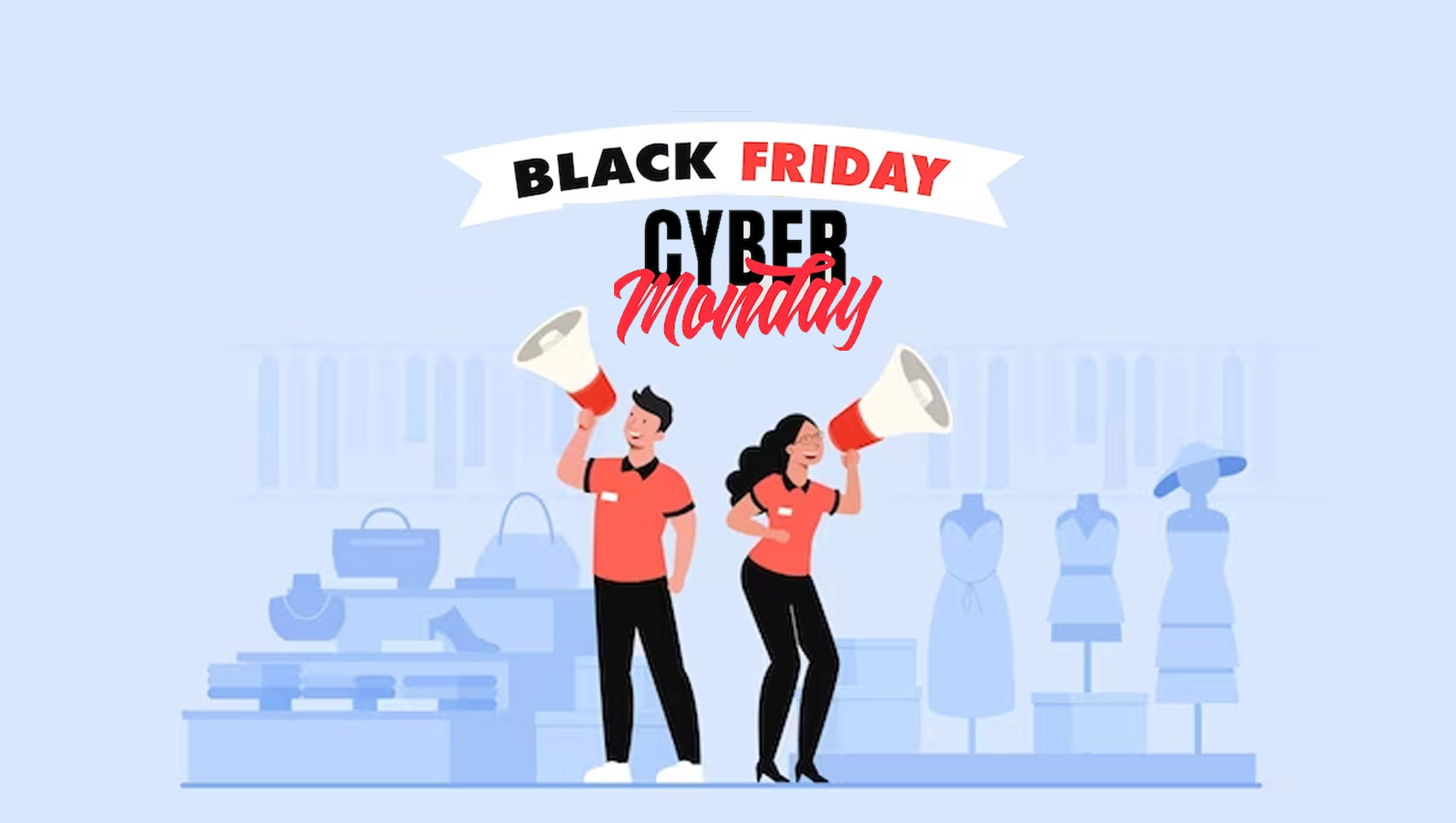Black Friday and Cyber Monday take center stage in the retail extravaganza because this is the season of buying. But, the annual extravaganzas have changed dramatically in recent years due to new retail practices and ever-changing consumer behaviors.
Today economic uncertainties and growing consciousness about prices among people have become paramount but Black Friday and Cyber Monday deals have never been so pronounced. In 2022, $11.3 billion was produced during this time and Cyber Monday alone offers a golden opportunity for organizations to produce substantial earnings.
Yet, it is said that great opportunities come with great responsibilities, and in the crowded retail arena of this holiday season brands need to rise above the noise to enchant consumers producing unparalleled buying experiences. The secret sauce is – to “craft exceptional customer journeys” by offering impeccable personalized interactions and impeccable product data quality. Those brands who master this art can gain a competitive edge and enjoy heightened customer loyalty and satisfaction.
What is Black Friday and Cyber Monday?
Black Friday and Cyber Monday are famous shopping events that originated in the United States but now they have become a global phenomenon. People look forward to these shopping events as they are associated with significant discounts and promotions that encourage people to shop. Consumers take advantage of special deals and retailers have a chance to get maximum sales at this time.
Black Friday falls on the day after Thanksgiving in the United States which is the fourth Thursday of November. This is the beginning of the Christmas shopping season. Black Friday originated in Philadelphia in 1950 and retailers began turning a profit, moving from being in the red to being in the black so they transitioned from operating at a loss to earning the profit “back to black” before the end of the fiscal year.
Earlier, Black Friday was associated with in-store shopping when stores used to open in the morning and there were long lines of customers camping outside stores to take advantage of discounts. Now, online retailers have embraced the concept and offer deals on their websites so people choose to shop online rather than being in crowded places and shop from stores.
On the other hand, Cyber Monday is the Monday that immediately falls after Black Friday and it is centered around online shopping. It was created to encourage people to shop online and take advantage of internet deals. There are special promotions, discounts, and sales specifically for Cyber Monday. It includes reduced prices, free shipping, and various other incentives that are offered to online shoppers. It is famous for tech-related products, clothing, and holiday gifts.
Though these events originated in the US they have expanded globally and various countries participated in Black Friday and Cyber Monday when retailers are offering special promotions during this time.
Black Friday and Cyber Monday have grown in importance for businesses as they signal the start of the holiday shopping season and give customers the chance to score big savings on a variety of goods.
What Retailers Should Be Conscious About?
Retailers are invited into a world of never-before-seen potential and challenges as the holiday season approaches, marked by the legendary Black Friday. The National Retail Federation’s optimistic estimates, which indicate a 3-4% increase in holiday spending over last year, provide firms with a bright canvas despite economic uncertainties and inflationary worries. An enduring tradition,
Black Friday is driven not only by its historical significance but also by the revolutionary waves of early promotional activities like October’s Amazon Prime Big Deal Days.
The holiday scene of this year is dynamic, molded by precursor sales and a reoriented sense of normalcy that has an impact on changing consumer behaviors. Marketers are caught between tradition and innovation as consumers traverse this changing purchasing paradigm. They need to find flexible techniques that can grab the attention of keen consumers who are prepared to go on their yearly shopping expedition.
The analysis that follows will break down important trends and tactics in this complex dance of supply and demand, providing a thorough manual for marketers to handle the subtleties of Black Friday and the extended holiday season that comes after.
Black Friday’s Resilience in Shifting Tides
Black Friday is a constant in the ever-changing world of holiday shopping, even in the face of fluctuations in the economy. Its tenacity is strengthened by the revolutionary currents of contemporary consumerism in addition to its historical roots. Early promotional events—Amazon Prime Big Deal Days in October, for example—have become a major force in forming the patterns of modern consumer behavior.
Black Friday is a constant in the ever-changing world of holiday shopping, even in the face of fluctuations in the economy. Its tenacity is strengthened by the revolutionary currents of contemporary consumerism in addition to its historical roots. Early promotional events—Amazon Prime Big Deal Days in October, for example—have become a major force in forming the patterns of modern consumer behavior.
The finding that 22% of consumers base their Christmas shopping decisions on e-commerce sales days, such as Prime Day, is possibly the most persuasive. This change highlights how easily consumer behavior can be influenced, and it also offers local firms a sizable window of opportunity. Rather than being a thing of the past, Black Friday has become a dynamic force that has shaped and adjusted the story of Christmas shopping in a time when innovation and tradition coexist.
Marketing Technology News: MarTech Interview with Celia Fleischaker, Chief Marketing Officer at isolved
Keeping this in mind let’s unravel some pivotal trends that influence Black Friday and Cyber Monday deals this year. So, Let’s explore how your brand can harness the full potential of each trend discussed below:
Trend 1: Social Commerce Unleashed: Trends in Consumer Behavior
Social commerce has become a revolutionary force in the kaleidoscope of contemporary consumerism, changing the landscape of holiday buying. The stage is set for a dynamic interplay between brand loyalty and shareable content, with beauty and home items leading the way. The Influencer Marketing Factory conducted a recent survey that reveals the complex preferences underlying the social commerce revolution.
- Offer Affordable Shopping Experiences:
The attraction of limited-time deals is irresistible to the 18–34 age group, drawing them into the world of social commerce. Because of their natural need for exclusivity and rapid pleasure, this group considers limited-time offerings to be irresistibly time-sensitive. On the other hand, people over 35 tend to favor the practical appeal of free shipping. The appeal of affordable shopping experiences combined with the ease of having items delivered to their door without extra fees makes this group a target market for companies that provide free delivery.
- Dominate social commerce when branching out into clothing, cosmetics, or House appliances.
As the poll delves deeper into the product categories, it reveals a profound shift in consumer preferences. 60% of all purchases made through social commerce are made up primarily of apparel, cosmetics, and household items. This represents a significant 25% increase over the previous year, highlighting the categories’ unquestionable momentum in the social commerce space.
Facebook and Instagram Shops are the clear leaders in this field, receiving high marks for both the social commerce experience and the sometimes neglected checkout process. These platforms become necessities for companies looking to dominate social commerce when branching out into the clothing, cosmetics, or home goods industries.
The core of this social commerce boom is aptly captured by Fernando Angulo, Senior Market Research Manager at Semrush, who highlights the complex role that social media plays in product discovery.
Personalized email marketing promotions, optimized mobile web browsing, and targeted social media ads are becoming essential for businesses looking to capitalize on social commerce, as consumers shift their spending habits towards immersive digital experiences.
Social commerce is the crescendo, the harmonious union of digital contact and purchasing power, in the symphony of trends reshaping consumer behavior. Businesses tuned into the pulse of social commerce will find themselves conducting a symphony of customer interaction as the holiday shopping season progresses, rather than just being participants.
Trend 2: Ethical Considerations: Elevating Brands through Social Responsibility
Customers’ interests are shifting beyond the appeal of individual products, as they look for more information about a company’s social responsibility. Brands that prioritize social responsibility are well-positioned to foster enduring brand loyalty at a time when customers are drawn to values.
According to Fernando Angulo, companies may set themselves apart on Black Friday by emphasizing their commitment to sustainability and social responsibility. A sophisticated consumer base is more drawn to brands that share their beliefs. Organizing campaigns that highlight moral behavior is a calculated step for businesses trying to establish a lasting relationship with morally aware consumers
Trend 3: Mastering the Art of Email Marketing: Crafting Thoughtful Narratives
Amidst the deluge of emails that flood consumers’ inboxes around the holidays, the craft of crafting a compelling email design becomes increasingly important for leaving a lasting impression. The CEO of Holistic Email Marketing, Kath Pay, is an advocate for carefully designing attention-grabbing subject lines and preheaders that complement each other to grab readers’ attention.
Additionally, using psychological insights into email design might help customers navigate the online store. Pay suggests a gradual ramp-up timetable for lapsed clients in order to prepare the IPs for higher email volumes and frequency. Pay emphasizes the value of customer-centricity in a time of increased competition, pushing companies to concentrate on offering bargains that are too good to refuse and that put the needs of their customers first.
Trend 4: In-Store vs. Online Preferences: Striking the Right Balance
The evolution of Black Friday, from its beginnings as an in-store frenzy to the welcoming Cyber Monday and Cyber Week promotions, is indicative of the changing tastes of consumers. Customers today express a preference for a well-rounded holiday buying experience that includes both in-store and online encounters.
According to a survey conducted by marketing automation company Klaviyo, consumer preferences are not clear-cut: 45% of respondents say they prefer online shopping, 20% say they prefer in-store experiences, and a noteworthy 35% say they have no choice at all. This detailed analysis emphasizes how important a multi-channel marketing strategy is.
Fernando Angulo stresses the value of creative content marketing, influencer cooperation, and combining traditional media with social media. By meeting a variety of consumer demands, this all-encompassing strategy promotes greater brand awareness and customer involvement.
Trend 5: Elevated Promotions And Discounts are the linchpin of Success During Black Friday and Cyber Monday
Promotions still continue to be the crucial element for success during Black Friday and Cyber Monday seasons. It is especially important at this time when the cost of living crisis is everywhere. Shoppers are seeking irresistible deals, discounts, and exclusive offers at this time actively so it is critical to understand that the promotional landscape has evolved beyond mere price cuts. Consumers want maximum value for the money they spend. In 2023, you can win holiday sales if you offer attractive discounts and promotions because everyone is looking to save.
Be transparent when offering discounts, email subscriptions, and value-based perks like free delivery. This will help foster the loyalty and trust of your customers because they want high value for money.
Trend 6: Personalized Recommendations & Product Bundles goes hand in hand
The market is competitive and personalization is the cornerstone to building customer loyalty and satisfaction. Now, the one-size-fits-all approach will not give fascinating results. This trick falls short because brands are leveraging data-driven insights to deliver highly personalized experiences to their audience that are based on the consumer’s actions and preferences. True personalization is beyond using first names in emails. It is about understanding the customer’s pain points, their preferences, browsing behavior, and purchase history.
Brands should craft customized messages and product recommendations that resonate with each shopper individually and organizations should collect and centralize customer data from different sources to achieve this. They must use advanced analytics tools and machine learning algorithms for identifying patterns and trends. During Black Friday and Cyber Monday, brands must leverage these insights and recommend products along with products and promotions that meet the preferences of every shopper you come across. Curated product bundles as per the interest of the customer or their past purchase with special prices can turn into enticing opportunities for customers to explore complementary items and other purchases.
Trend 7: Hybrid Experiences: ROBO & BOPIS
During the holiday shopping season, Hybrid Experiences are becoming more and more popular as people strive for convenience and ease. The varied shopping tastes of today’s consumers are acknowledged by tactics like BOPIS (Buy Online, Pick Up In-Store) and ROBO (Research Online, Buy Offline). The contemporary consumer frequently starts their shopping trip online, looking up products and comparing costs. Still, there is a need to handle a product in person before deciding on it.
Customers can pay online and pick up their items in-store in a matter of hours thanks to BOPIS, which satisfies their need for quick gratification. This offers instant access to chosen things and does away with delivery wait times. These hybrid approaches are beneficial to merchants because BOPIS lowers transportation costs and improves the effectiveness of inventory management. ROBO additionally promotes physical store visits which leads to additional in-store purchases further.
Trend 8: Uniformity Throughout Touchpoints
Nowadays, customers engage with companies across a variety of touchpoints, expecting a smooth online and offline experience. Since a consistent brand experience promotes dependability and reliability, consistency is essential to developing trust. Consistent messaging, design, and experiences across all touchpoints foster trust, which is essential to sustaining long-term consumer loyalty.
A consistent brand experience helps reinforce brand identity and values in addition to fostering trust. Customers should experience the same brand messaging and aesthetics both online and in-store to promote brand recall and identification.
Consistency simplifies procedures from an operational standpoint by cutting down on complexity and mistakes. Operational efficiency is ensured by a consolidated approach to pricing, product information, and inventory management. This is especially important for high-stakes occasions such as Black Friday and Cyber Monday.
Trend 9: Innovative Technologies for Immersive Experiences
Innovation in the retail industry is characterized by the incorporation of advanced technologies such as Augmented Reality (AR) and Artificial Intelligence (AI). With this integration, consumer interactions with products and brand engagement will be radically changed in favor of more immersive and engaging experiences.
With AI’s data-driven capabilities, brands can now provide real-time support via chatbots, personalized recommendations, and predictive analytics for inventory management. Conversely, augmented reality (AR) fills in the gaps between the digital and real worlds by enabling users to see products in their own environments, try on virtual clothes, and even take virtual car tests. Through the ability to make better-informed decisions, these technologies not only increase customer engagement but also cultivate trust.
Industries like fashion, electronics, and automotive are primed to offer unique and unforgettable experiences as marketers use AI and AR into their strategy, making them stand out during high-stakes events like Black Friday and Cyber Monday.
A Few Strategies For A Successful Holiday Season
1. Agile Marketing
Embrace flexibility in marketing strategies. Analyze real-time data and adjust campaigns accordingly. This adaptability is crucial in navigating the unpredictability of consumer behaviors.
2. Personalization
Tailor marketing messages based on individual preferences and behaviors. Leverage data analytics to understand customer journeys and deliver personalized experiences, enhancing customer satisfaction and loyalty.
3. Omni-Channel Experience
Seamlessly integrate online and offline channels to provide a unified shopping experience. Consumers today expect a consistent brand experience, whether they interact with a brand in-store, online, or via social media.
4. User-Generated Content
Encourage customers to share their experiences through user-generated content. This not only creates authentic brand narratives but also fosters a sense of community around your products or services.
5. Strategic Partnerships
Collaborate with other businesses or influencers to expand reach and tap into new audiences. Strategic partnerships can bring a fresh perspective and amplify the impact of marketing efforts.
6. Post-Holiday Engagement
The holiday season extends beyond December. Maintain engagement with customers through post-holiday promotions, loyalty programs, and content that resonates with the spirit of the season.
Marketing Technology News: Broaden Creator-Driven Marketing With Real And Virtual Presenters
Conclusion: Charting the Course for a Successful Holiday Season
Marketers must remain flexible as the holiday shopping scene changes, utilizing these trends and techniques to increase brand awareness, stimulate consumer interaction, and take advantage of the numerous opportunities that Black Friday and Cyber Monday bring. These trends promise to completely reshape the holiday shopping experience by providing the ideal balance of consistency, creativity, and ease.
By leveraging these patterns as Black Friday and Cyber Monday draw near, organizations have the opportunity to establish lasting impressions and strengthen their relationships with their target audience, paving the way for a prosperous holiday season and beyond. These trends and strategic insights weave together to create a complicated picture that gives marketers a detailed road map for navigating the challenges of the holiday shopping season.
Businesses may not only survive but succeed in the dynamic world of holiday marketing by embracing flexibility, prioritizing customization, nurturing an omnichannel experience, utilizing user-generated content, forming strategic alliances, and sustaining post-holiday engagement.
Holiday shopping is a dynamic journey, and marketers need to be adept at both reading consumer emotions and steering their strategies. Those that successfully navigate this path will find themselves floating into a wealthy holiday season and beyond, as the waves of consumer behavior rise and fall.











